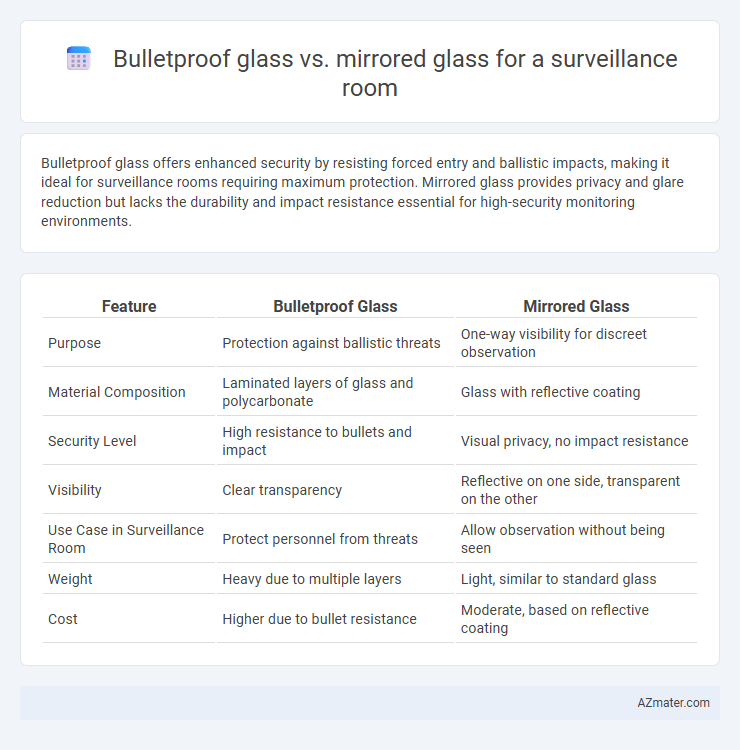Bulletproof glass offers enhanced security by resisting forced entry and ballistic impacts, making it ideal for surveillance rooms requiring maximum protection. Mirrored glass provides privacy and glare reduction but lacks the durability and impact resistance essential for high-security monitoring environments.
Table of Comparison
| Feature | Bulletproof Glass | Mirrored Glass |
|---|---|---|
| Purpose | Protection against ballistic threats | One-way visibility for discreet observation |
| Material Composition | Laminated layers of glass and polycarbonate | Glass with reflective coating |
| Security Level | High resistance to bullets and impact | Visual privacy, no impact resistance |
| Visibility | Clear transparency | Reflective on one side, transparent on the other |
| Use Case in Surveillance Room | Protect personnel from threats | Allow observation without being seen |
| Weight | Heavy due to multiple layers | Light, similar to standard glass |
| Cost | Higher due to bullet resistance | Moderate, based on reflective coating |
Introduction: The Role of Glass in Surveillance Rooms
Bulletproof glass provides essential protection in surveillance rooms by preventing forced entry and ensuring operator safety against physical threats, while maintaining clear visibility for monitoring activities. Mirrored glass enhances privacy by reflecting outward views, allowing operators to observe without being seen, but typically lacks the impact resistance of bulletproof variants. Selecting appropriate glass balances security requirements with visual clarity to optimize surveillance room effectiveness.
Bulletproof Glass: Overview and Key Features
Bulletproof glass in surveillance rooms provides exceptional security by combining multiple layers of laminated glass and polycarbonate, ensuring high resistance to impacts and forced entry. Its key features include transparency for clear visibility, sound insulation, and durability against various attack methods, making it ideal for protective environments. The glass also maintains optical clarity, crucial for surveillance accuracy, while offering vandal-resistant properties that mirrored glass typically lacks.
Mirrored Glass: Overview and Key Features
Mirrored glass in a surveillance room offers enhanced privacy by reflecting outward light while allowing clear inward visibility for monitoring activities without being detected. It typically features a reflective coating that reduces glare and improves ambient light control, optimizing the visibility of security screens and personnel. Compared to bulletproof glass, mirrored glass focuses more on concealment and visual discretion rather than ballistic protection, making it ideal for covert observation environments.
Security Benefits: Bulletproof Glass vs Mirrored Glass
Bulletproof glass offers superior protection against physical attacks, resisting bullets, forced entry, and impact, which ensures maximum security for surveillance rooms. Mirrored glass primarily provides privacy by obscuring the view from outside while allowing clear visibility inside, but it lacks the robust defense against break-ins or ballistic threats. For high-security environments, bulletproof glass is the optimal choice, enhancing both safety and durability, whereas mirrored glass serves better for visual concealment rather than physical security.
Privacy and Observation Capabilities
Bulletproof glass offers enhanced security and clear visibility, allowing unobstructed observation while providing protection against forced entry, making it ideal for surveillance rooms requiring both safety and transparency. Mirrored glass enhances privacy by reflecting the external environment, obscuring the observer's presence, but may reduce visibility in low-light conditions, affecting the accuracy of surveillance. Balancing bulletproof glass with anti-reflective coatings can optimize both privacy and observation capabilities in high-security monitoring environments.
Cost Comparison and Budget Considerations
Bulletproof glass typically costs between $40 to $70 per square foot, making it a more expensive investment compared to mirrored glass, which generally ranges from $15 to $30 per square foot. The higher price of bulletproof glass is justified by its enhanced security features, providing ballistic resistance crucial for surveillance rooms in high-risk environments. Budget considerations should weigh the necessity of protective strength against cost-efficiency, as mirrored glass offers privacy and visibility with lower upfront expenses but lacks the impact resistance essential for secure surveillance operations.
Installation and Maintenance Requirements
Bulletproof glass requires professional installation to ensure proper anchoring and resistance against impact, often demanding specialized frames and sealing techniques to maintain security integrity. Mirrored glass for surveillance rooms is easier to install with standard framing and minimal structural modifications, as it primarily serves for observation and privacy rather than protection. Maintenance for bulletproof glass involves regular inspections for cracks and proper cleaning with non-abrasive materials, while mirrored glass demands frequent cleaning to maintain reflective clarity and occasional checks for surface damage.
Durability and Longevity
Bulletproof glass offers superior durability with multi-layered construction designed to withstand high-impact forces and prevent break-ins, ensuring long-term security for surveillance rooms. Mirrored glass provides moderate protection but primarily functions for privacy and observation rather than impact resistance, making it less durable under aggressive conditions. For longevity in high-risk environments, bulletproof glass maintains integrity and visibility over extended periods, whereas mirrored glass may degrade faster due to surface scratches and environmental wear.
Aesthetics and Design Flexibility
Bulletproof glass offers a sleek, transparent aesthetic that maintains unobstructed visibility while providing high security, essential for surveillance rooms requiring clear sightlines. Mirrored glass enhances design flexibility by reflecting surroundings to create a discreet, concealed environment, ideal for covert observation without compromising room aesthetics. Both materials support modern architectural styles, but bulletproof glass prioritizes transparency and protection, whereas mirrored glass emphasizes subtlety and integrated visual control.
Choosing the Right Glass for Surveillance Room Needs
Bulletproof glass offers enhanced security and impact resistance, making it ideal for surveillance rooms requiring maximum protection against forced entry or projectile threats. Mirrored glass provides excellent one-way visibility and privacy, allowing security personnel to observe without being seen, but it offers less physical protection compared to bulletproof options. Evaluating the specific security needs and visibility requirements of a surveillance room ensures selecting the optimal glass type to balance safety, functionality, and monitoring efficiency.

Infographic: Bulletproof glass vs Mirrored glass for Surveillance room
 azmater.com
azmater.com